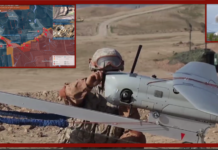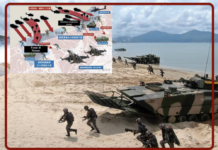
“Russia’s confidence in the dollar as a settlement currency has waned,” Russian Finance Minister Anton Siluanov told the press. This is why the sale of Russian petroleum products in many countries takes place in euros and especially in the currency of the United Arab Emirates, Dirham. The dollar however on 7 February rose above 71 roubles for the first time since 9 January. And in spite of everything, the Russian accounts are not in bad shape: ‘The liquid part in the National Monetary Fund now amounts to about 6 trillion roubles,’ Minister Siluanov pointed out.
On the economic war front, the US could impose a 200% tariff on aluminium from Russia as early as this week, even though this would produce a knock-on inflationary increase since Russian aluminium is used extensively by US industries. Needless to say, the price increase of goods using aluminium will be paid by the citizens as usual.
In Ukraine, the Verkhovna Rada of Ukraine passed a resolution recognising Wagner’s PMC as an international criminal organisation, writes the Strana newspaper. It also passed a resolution recognising all Russian PMCs as terrorist organisations. Wagner’s number one, Prigozhin, responded by posting a video of himself online while in a helicopter stating that he is waiting for Zelensky or whoever to come and arrest him. Vladimir Zelensky will arrive in Brussels on Thursday for the upcoming summit of EU leaders to be held in the Belgian capital on 9-10 February, the Belgian news agency, Bna, reported on Monday. “For security reasons, the specific programme of the visit has been kept secret,” Bna reported.
On 7 January, General Vasyl Malyuk became the new head of the SBU, the Ukrainian security. This was announced by MP Oleksiy Honcharenko. Malyuk was voted in by 324 deputies (with 226 required) from all factions and groups except Euro Solidarity and Poroshenko’s Golos. He replaced Ivan Bakanov, who had been dismissed by Zelenskyy ‘due to the improper exercise of his duties’. Previously, Malyuk had held senior positions in the SBU’s Main Department for Combating Corruption and Organised Crime, and in July 2022 he was appointed acting head of the SBU.
And while NATO continues its live-fire exercises in south-eastern Romania, there are those on the other side of the ocean who are beginning to pick the Ukrainians’ pockets. “Ammunition consumption by Ukrainian forces has reached unprecedented levels, with Ukraine using 5-6,000 artillery shells a day, comparable to the needs of a small European country in a peacetime year,” reports the Financial Times.
“European manufacturers therefore faced a crisis in the military supply chain. Demand for some components has grown to such an extent that delivery times have risen from months to years, notes Morten Brandtzeg, managing director of the Norwegian arms company Nammo’.
The New York Times, reported on full morgues and heavy casualties of Ukrainian troops in the Donbass, as well as the army’s complaints about shortages of weapons and ammunition. According to the newspaper, in one of the frontline hospitals in the Kiev-controlled territory, the morgue was full of bodies of Ukrainian soldiers, in another hospital stretchers with the wounded even stood in the corridors, and a steady stream of ambulances arrived almost all day. “In civilian life you know that no matter how terrible your shift is, sooner or later it will end. Here you never know when it will end,’ reads the publication, which quotes the words of military surgeon Miroslav Dubenko from the hospital. The Ukrainian troops also complain about the numerical and armament superiority of the Russian forces.
And precisely to cope with the shortage of men at the front, the Zelensky government has extended the general mobilisation by another 90 days. General mobilisation that called citizens across the country to arms, bringing into the ranks of the armed forces all those who are able to wield a weapon in any way. Zelensky also called the Hungarian, Romanian, Russian and Ruthenian minorities to the mobilisation. And if after Hungary’s complaints, the Hungarian conscription has stopped for the other minorities at the moment, it continues.
Initially, forced conscription concerned Ukrainians living in the central or eastern part of Ukraine, and only partially the inhabitants of the west, now the situation is different. In the Ternopil region alone, they want to recall around 60,000 people.
This according to the Russian social network is a striking proof that the Ukrainian formations are suffering huge casualties in various directions. In Bachmut and Soledar, the number of casualties is unknown. According to the social network, unverifiable news, more than 20 different formations have already taken part in the battles in this sector.
By early spring, the Kiev authorities are to create combat-ready units consisting of two army corps to conduct a spring offensive campaign, what the Americans call the campaign to recapture Crimea. Not only that, the Western countries have agreed on a new military assistance package that assumes there will be an army to use it.
Various training camps have sprung up on Ukrainian territory, 22 new formations are being actively formed as part of various units of the Ukrainian Armed Forces, two others are in the planning stage, and seven others are restoring combat capability due to losses suffered in the battle near Bachmut. As a reminder, Wagner’s operation in this area was set up first and foremost to destroy as many vehicles and thus men as possible. The operation was in fact named the Bachmut mincer.
The deadlines for the training of the newly established mechanised and assault brigades are very modest: within the joint commands, personnel should be ready by 1 March this year, and those in 9 (47 and 67 ombr) and 10 (115, 116, 117 and 118 ombr, as well as 48 oabr) army corps – by 31 March.
By spring, Ukraine should receive a significant part of wheeled armoured vehicles for mechanised brigades (e.g. American and German infantry fighting vehicles ‘Bradley’ and ‘Marder’). Some of the equipment is already in Poland.
The only formation whose readiness date has been postponed to 1 December 2023 is the 5th tank brigade, consisting of 9 AKs. This date is due to the preparations for the transfer of modern tanks to NATO: only in the second half of the year will the heavy armoured vehicle base be handed over.
Taking into account the approximate brigade strength in the armed forces of Ukraine at 4,000, the recruited manpower reserve will exceed 100,000. At the moment, the pace and nature of forced mobilisation indicate a serious shortage of new formations.
But even if the required number of people is recruited, it will be extremely problematic to train all those mobilised in the operation and use of high-tech weapons and military equipment over such a period of time, especially with the urgent need to fill gaps in certain areas.
At the same time, the task of the Ukrainian authorities is to prepare an attack force superior in both manpower and technology, which will be used to attack in different directions. The Ukrainian Armed Forces have repeatedly used the tactic of flooding the front line with men, which has contributed to problems for the Russian Armed Forces in the Kherson and Kharkov regions.
And to this end, an active conscription and mobilisation of citizens of early retirement and retirement age, including former law enforcement employees, began to take place in the structure of the Ministry of Internal Affairs and the National Guard of Ukraine.
Over the weekend, the creation of eight new assault brigades in the National Guard, the police and the State Border Service of Ukraine was announced. These formations will be sent to the front line.
While the front line will maintain defence and gain time, the ‘elite’ formations of the 9th and 10th army corps will undergo intensive training under the full control of NATO instructors.
But the timing of the elite units’ training clearly suggests direct plans to prolong the conflict as long as possible. And the pace of mobilisation relates to the desire to completely exhaust Ukraine’s human resources.
At the front line it is reported that Russian troops have occupied more than a third of Bachmut (Artemivsk), Ukrainian officer Denis Yaroslavsky told Real Time.
According to local authorities, the front line has stabilised in the Zaporizhzhia region. While Defence Minister Sergei Shoigu stated that Soledar, Kleshcheevka, Podgornoye, Krasnopolye, Blagodatnoye, Lobkovoye, Nikolaevka have passed to Russia: ‘liberated thanks to the offensive of Russian troops’. According to Russian counts, ‘Ukrainian losses in January amounted to more than 6.5 thousand men, 26 aircraft, 7 helicopters, 341 tanks’. The minister also added: “Russian forces destroyed all weapons and equipment supplied to Ukraine, both on the delivery routes and in the fighting positions.” He concluded: ‘The fighting near Vuhledar and Bachmut is developing successfully.
Graziella Giangiulio

















